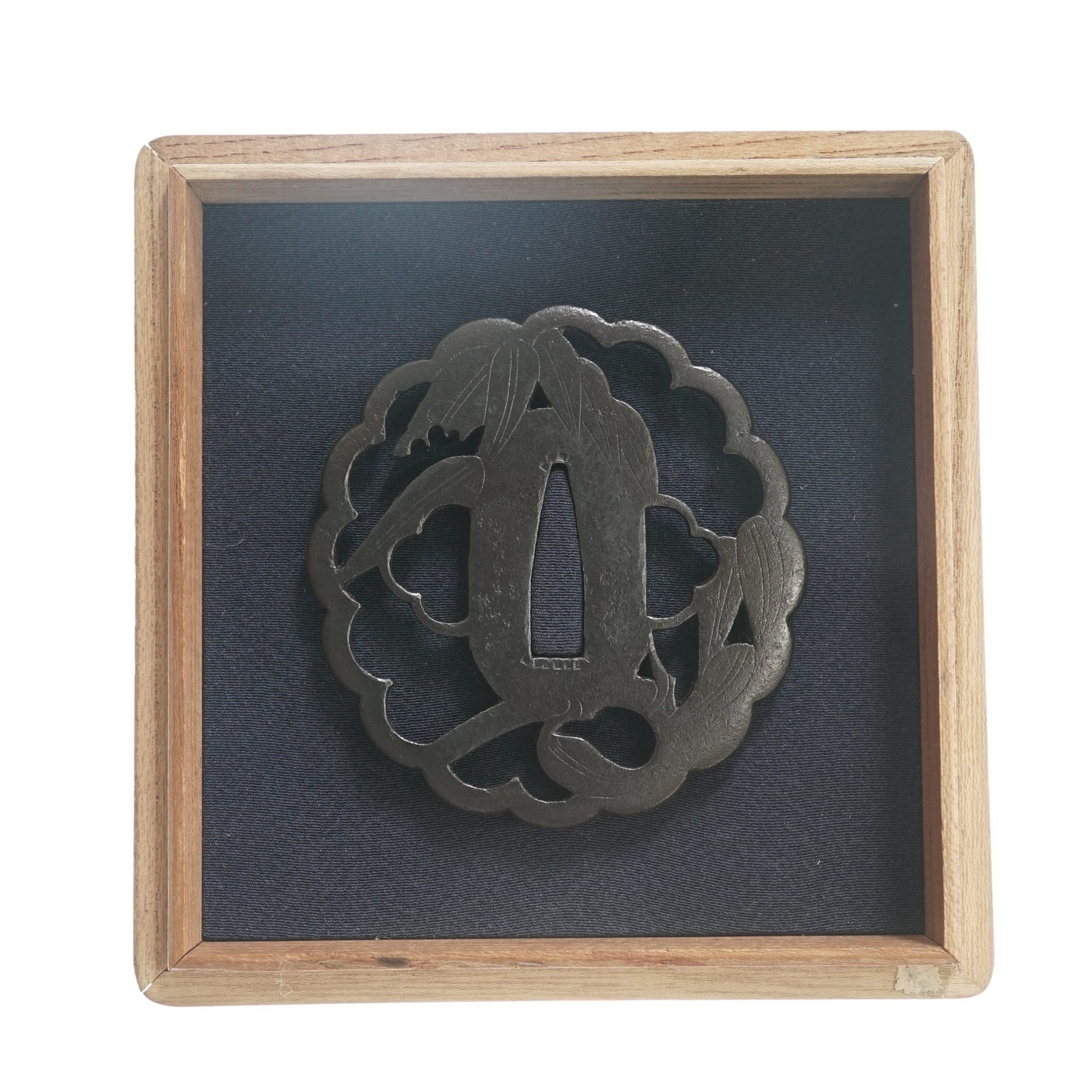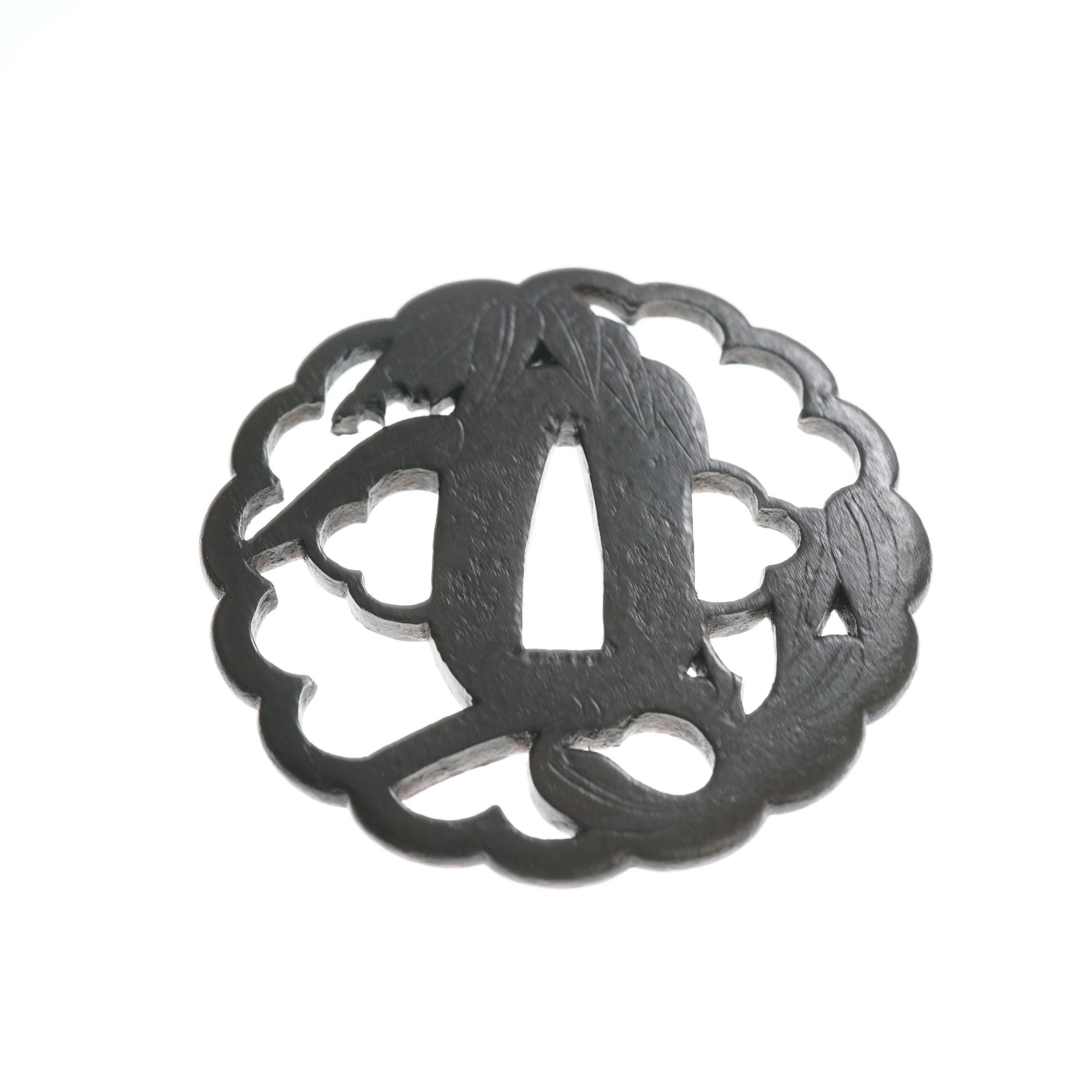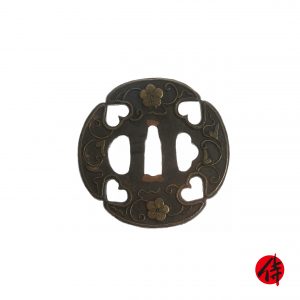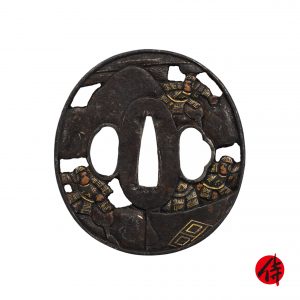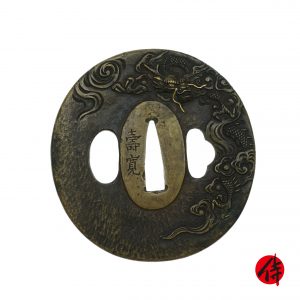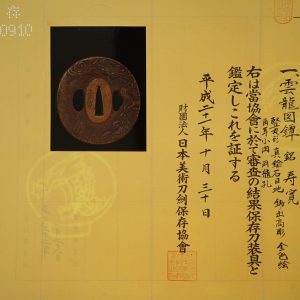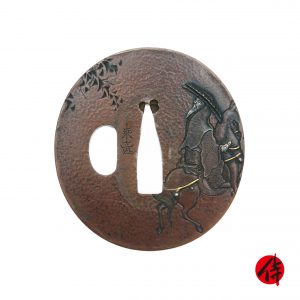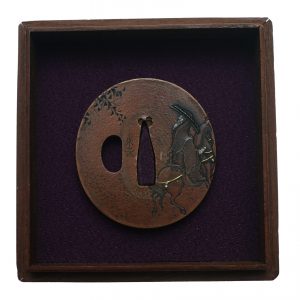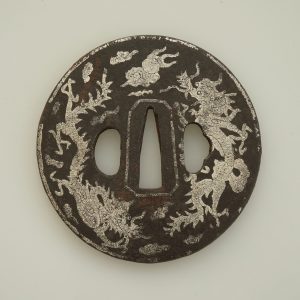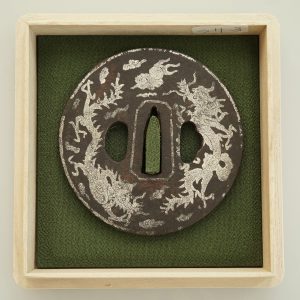Title: Higo-style, Shiori Take Sukashi
Description
Iron Tsuba with two holes
Its edge has an engraving of chrysanthemum shape. Bamboo shaped openwork decorates its inside. Shiori means a segmented branch of bamboo, and Take means bamboo. Chrysanthemum is one of the flowers that symbolize the fall, and people appreciate it very much since ancient times. As its petals form radially, this flower is likened to the sun. That is the reason why this motif is treated as the symbol of perpetual youth and longevity or good health. “Kiku no Gomon” is a kind of chrysanthemum pattern, and it is used as the crest of the emperor and the royal family in Japan so that it’s well-known as a noble pattern.
As bamboo grows tall soon, it is thought lively plants. And bamboo joints are considered it represents moderation. Its green color is also treated as a clean color. Therefore, it has been designed for many craft works as a good-luck omen. Based on this idea, bamboo is believed it is the symbol of eternal and longevity.
Higo-style Tsuba was established in Kumamoto prefecture in the Edo period, Kanei era (1624-1645), and made mainly in Kumamoto city and Yatsushiro city. Tadaoki (Sansai) Hosokawa took the lead to produce this style with other artists. He worked for Yoshiteru Ashikaga, Nobunaga Oda, Hideyoshi Toyotomi, and Ieyasu Tokugawa. So, he served people in authority of the time and laid the foundation for the Hosokawa family. Tadaoki is known as intellectual Samurai. He studied under Sen no Rikyu, who is considered as the most profound influence of the way of Japanese tea. And Tadaoki started the Sansai-style of Chanoyu (way of tea). In Higo-style metalworkers, four prestigious schools did excellent work; Hayashi family, Hirata family, Nishigaki family, and Shimizu family. They were good at not only Tsuba but also other sword mountings such as Fuchi Kashira and Menuki. In the Edo period, Higo-style Tsuba was a trendy brand among Samurai.
This Tsuba is recognized by The Society for Preservation of Japanese Art Swords, which is known as NBTHK.
*As this item is an antique, please check each photo and ensure its condition.
What is Tsuba?
Tsuba is the hand-guard of the Japanese sword. High-class Samurai wore his katana sword with its beautiful sword mountings such as Tsuba. Tsuba’s front design tends to be more decorative as this part was often seen by other Samurais when he was walking on the streets.
Why is it that the sword mounting was important for Samurai?
The sword mountings of the Japanese sword have many kinds of decorations such as handguards (Tsuba), sword hilt (Menuki), pommel (Fuchi Kashira). The sword mountings of the Japanese sword have many kinds of decorations such as handguards (Tsuba), sword hilt (Menuki), pommel (Fuchi Kashira). The Japanese sword worked as a weapon and as an object to show who he was. For example, it shows their personalities and beliefs. You could say that it is like decorations for smartphones today. We recommend you zoom in on the pictures of the sword fittings. When you do so, you can see the skill of Japanese metal engraving techniques. They are mainly made of iron and copper with inlays of gold, silver, and bronze. When it comes to handguard (Tsuba), each one has a different outline and weight. These sword fittings that have lived with Japanese swords of the same age might be worth as much as the Japanese swords. They are inconspicuous parts of the Japanese sword. Nevertheless, if you are knowledgeable or particular about it, you will become a connoisseur of the Samurai.
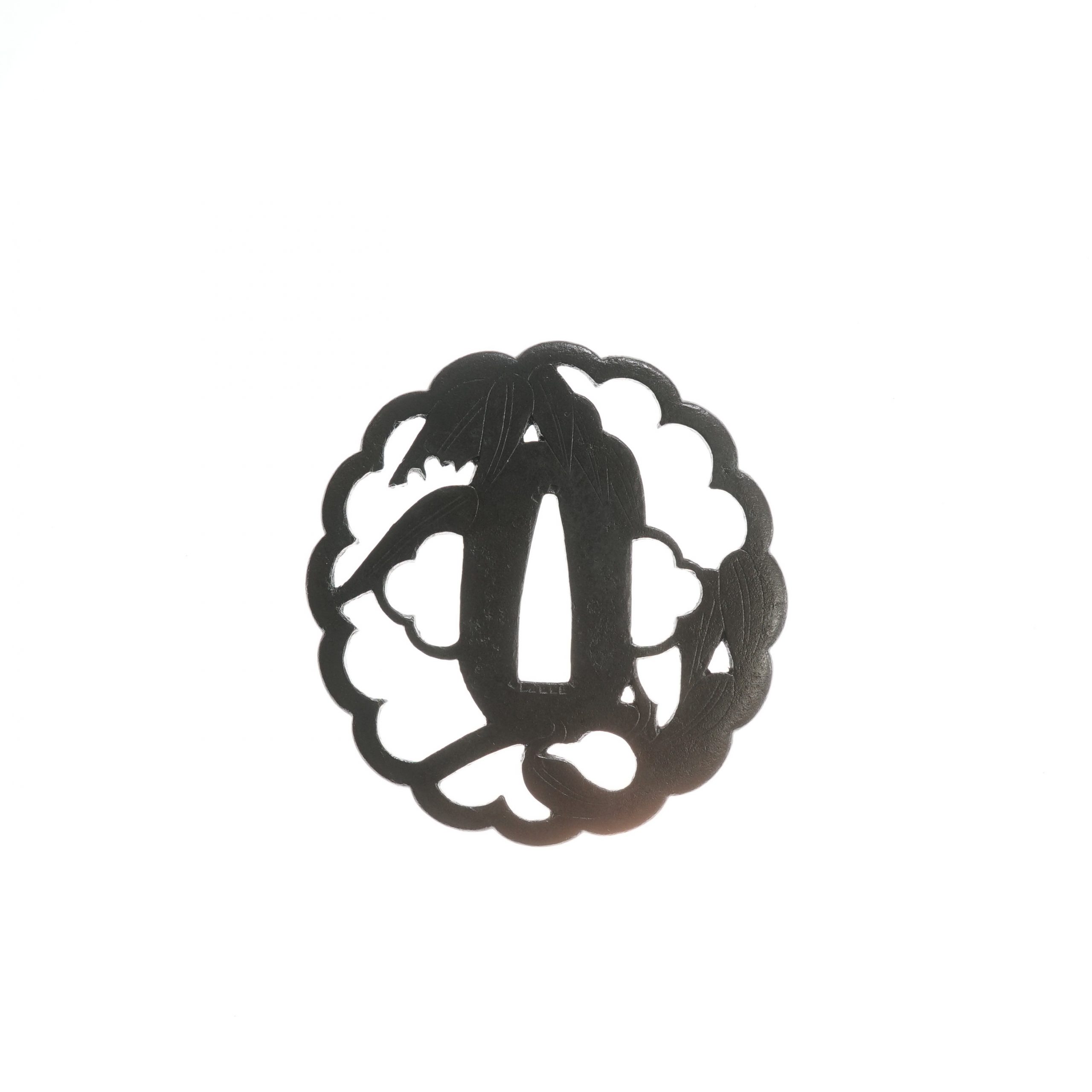
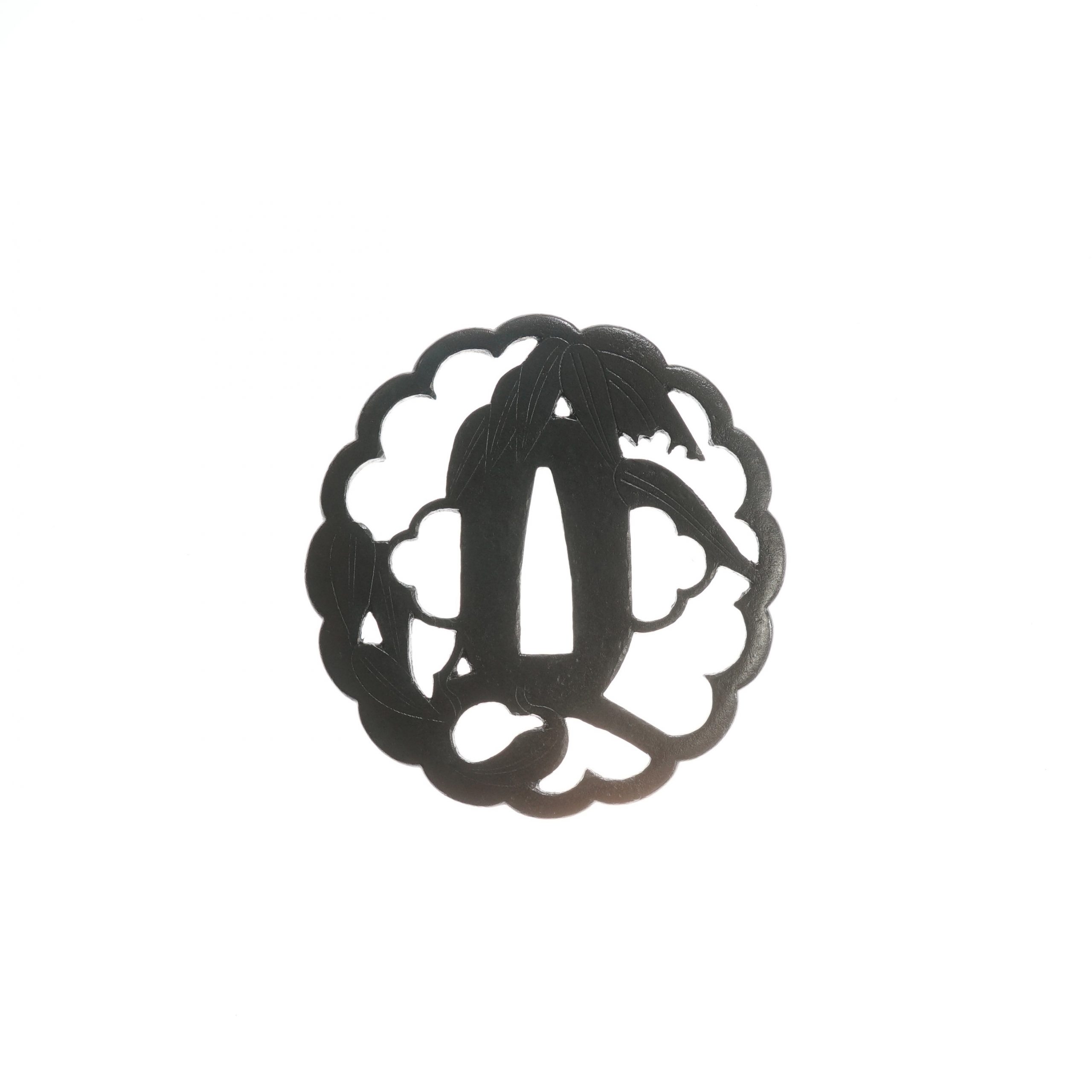

—————————————————————————————————————
About us
Samurai Museum is located in Tokyo, Japan, exhibiting antique artifacts related to the Samurai history. Samurai Museum Shop is the place for those who are interested in Japanese culture and craftsmanship. We deal with antique Samurai swords/armor, original Japanese sword mounting, traditional crafts made in Japan and so on.
Payment method
We accept payment through Stripe (Credit card) or Paypal. If you prefer other payment method, please contact us. You can either pay in Japanese Yen or US Dollars. The price is decided in Japanese Yen. The price in US dollar is calculated automatically based on an exchange rate.

Shipping Duration
We normally ship via EMS (Express Mail Service) provided by Japan Post. It usually takes at least 5-14 days to deliver the package after you place an order. We will use DHL instead for those who ordered from USA or Australia as EMS temporarily stops shipping to these countries due to COVID-19. We offer Free International Shipping as long as we can ship your order by either EMS or DHL. (USA, Australia only)
We will inform you of the order’s tracking number via email. Please make sure you fill out your valid email address correctly.
*Please keep in mind that due to the spread of COVID-19, there might be delays in shipping. If you like to know the detail about shipping, please feel free to ask us.


How to make sure the condition
We uploaded high resolution photos for you to check its condition thoroughly. If you like to see more photos with different angles, please feel free to contact us. We will be happy to send them to you so that you can make informed decision.
It is essential for us to know that you are happy with your choice of Tsuba and we are prepared to use the best of our ability to serve you.
How to appreciate Tsuba
Although Tsuba is a small component of Japanese sword mountings, we would say it is one of the most conspicuous parts. Also, unlike the blade itself, Tsuba has a low risk of handling. Furthermore, it does not require a large space for storage. Thus, Tsuba is relatively easy to collect. Here we would like to propose a few ways to enrich your Tsuba experience after purchasing your favorite Tsuba.
-Inspection
Inspect and feel the artistry of Tsuba. You will be amazed by the maker’s work quality to make it look a great work.
-Find the right place to display
Tsuba would look great when displayed in the best way. Find the best place in your house, your office, or anywhere you like, so that Tsuba would be appreciated as much as you like.
-Learn the details
Tsuba reflects quite a lot of detailed features of its maker. Sometimes you can find the maker’s signature on Tsuba. Tsuba makers tried adding elaborate artistry to Tsuba. Many techniques were invented to achieve this goal, such as openworks, engravings, and gold/silver inlays. There were many schools that trained Tsuba creators, and each of them has different characteristics. You would enjoy knowing these differences and find your beloved style.
What is included
This item will be packed in a wooden display box.
You will also receive the certificate (original) with this Tsuba.
Would you like see some more Tsuba for sale? Please check the link below. We hope you can find your favorite Tsuba.
https://www.samuraimuseum.jp/shop/product-category/decorations/tsuba/
